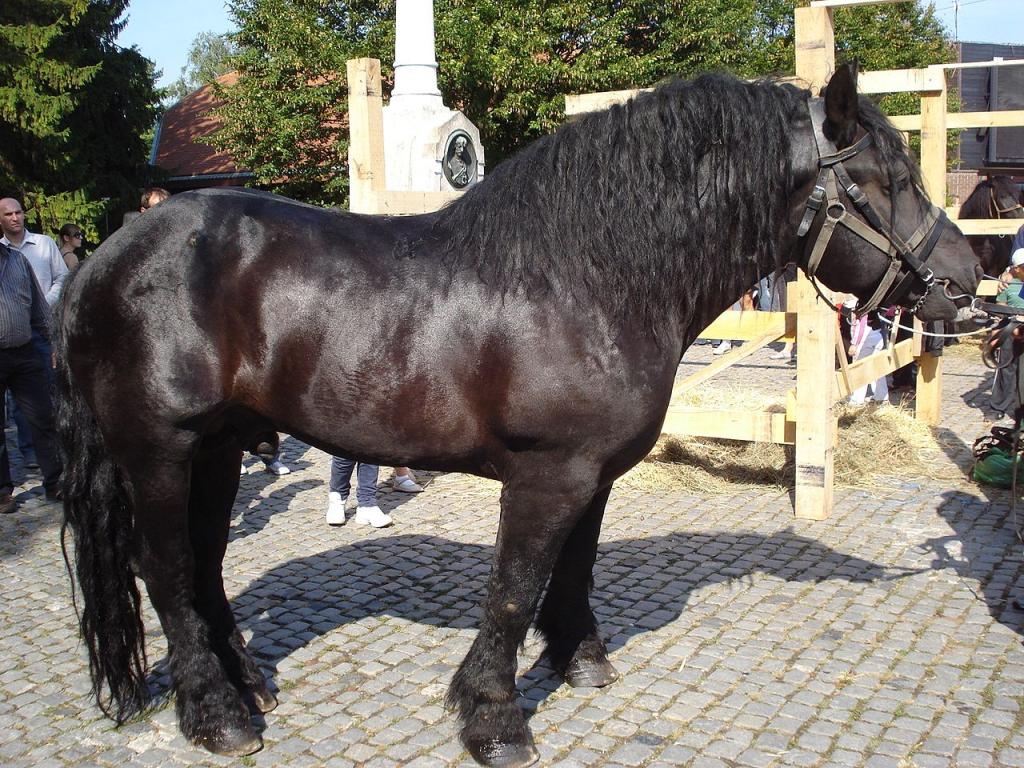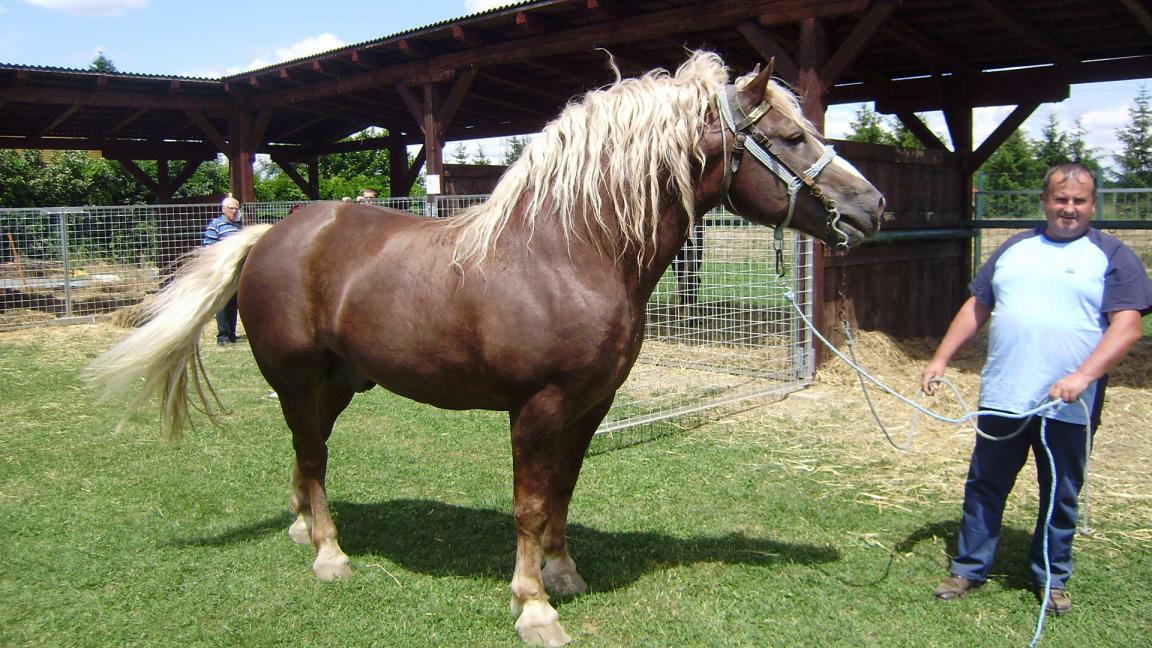
Continent: Europe
Country: Hungary
Weight: 500 – 600 kg
Height: 150 – 160 cm

The Međimurje, also known as Muraközi ló in Hungarian, is an indigenous heavy draft horse originating from the border region of Međimurje (northern Croatia) and Muraköz (south-western Hungary, near the Danube).
This area, marked by an ancient agricultural tradition, favored the emergence of a powerful and hardy horse, capable of meeting the daily needs of farmers.
The breed developed during the 19th century, through crossings between local horses and several major European draft breeds, notably the Percheron, the Ardennais, and the Noriker. The goal was to create an animal that was strong, docile, and enduring, well suited for heavy agricultural traction, forestry work, and transportation.
The main cradle of the breed is located in northern Croatia, in the Međimurje region, between the Drava and Mura rivers. It is here that the horse was traditionally selected and used for heavy agricultural work. Even today, the last organized breeding nuclei are found in this area, supported by national conservation programs.
Across the border, in south-western Hungary (Zala County and the Muraköz plain), the Međimurje is known as the Muraközi ló. Although numbers there are very low, the breed is still regarded as a rural heritage. A few farms participate in its preservation.
Small conservation herds also exist in Slovenia and occasionally in Austria, reflecting the breed’s historic presence throughout the Austro-Hungarian border region. However, breeding remains localized and limited, reinforcing its status as an endangered breed.
The Međimurje (Muraközi ló) represents a shared heritage of Croatia and Hungary. It embodies the peasant tradition of these border regions, where for generations it was the main working companion of farmers and foresters. Its preservation is considered essential to safeguard cultural memory and local rural identity.
Born from crossings with the Percheron, the Ardennais, and the Noriker, the Međimurje combines strength, hardiness, and endurance. Although it was never widely exported internationally, it contributed occasionally to local draft populations in Central Europe, improving their size and traction ability.
With agricultural mechanization and the decline of small farms, Međimurje numbers collapsed. Today, the breed remains endangered, making it a valuable genetic reservoir to preserve, especially for its hardiness, fertility, and longevity. National conservation programs aim to prevent its disappearance and maintain its genetic diversity.
The Međimurje (Muraközi ló) took shape during the 19th century in an agricultural border region between Croatia and Hungary. Farmers sought a horse that was strong, enduring, and docile, able to plow heavy soils and transport large loads. To meet these needs, local horses were crossed with Western European draft breeds such as the Percheron, Ardennais, and Noriker.
Until the mid-20th century, the Međimurje was an indispensable ally of farmers. Its traction power and robustness made it ideal for field work, timber transport, and daily hauling. In rural society, it symbolized the wealth and stability of peasant farms.
From the 1950s onward, with the rise of agricultural mechanization and the widespread arrival of tractors, demand for this type of horse collapsed. Many herds disappeared, and the population suffered a drastic decline.
In response to this decline, the breed was officially recognized and entered into studbooks in Croatia and Hungary. In the early 21st century, several genetic preservation programs were launched to avoid extinction, supporting breeders and promoting the horse’s cultural and touristic role.
Today, the Međimurje is regarded as a living heritage, representing the rural history of Central Europe and the peasant legacy of Croatia and south-western Hungary.
The Međimurje (Muraközi ló) is known for its placid nature, making it easy to handle even by less experienced people. Its docility allows it to work in harness or in the fields without showing excess nervousness.
Bred for heavy agricultural tasks, it combines physical endurance with remarkable patience. Accustomed to the slow and steady rhythms of plowing or hauling, it is distinguished by its constant willingness and resistance to effort.
The Međimurje adapts easily to outdoor living and to the sometimes harsh continental climate of Central Europe. It is a hardy horse, comfortable living in herds and integrating smoothly into collective environments.
Although its agricultural role has vanished, its calm and balanced temperament makes it suitable for leisure driving, traditional festivities, and cultural events, where it is presented as a heritage horse.
“The Međimurje is a patient and willing horse, once the faithful companion of farmers, today reborn as an ambassador of rural heritage.”
The Međimurje (Muraközi ló) is currently classified among rare and endangered breeds. The number of breeding individuals is very limited, and inbreeding poses a major risk to the population’s viability. Without conservation action, this local breed could disappear in the coming decades.
In Croatia, support measures have been introduced to encourage reproduction and maintain genetic diversity. In Hungary, the Muraközi ló also benefits from official registers and conservation programs, often linked to traditional farms. Cross-border partnerships are being studied to ensure joint management of the stock.
The future of the Međimurje may depend on a reconversion beyond intensive agriculture. Several initiatives aim to promote the horse through:
Beyond its local interest, the Međimurje is viewed as a unique genetic reservoir, carrying qualities of strength, hardiness, and endurance. Its preservation contributes to the diversity of European draft breeds and safeguards an important part of the rural history of Central Europe.
The Međimurje (Muraközi ló) is a robust draft horse, bred to work in demanding agricultural conditions. It has good physical resistance, a decent lifespan (20–25 years), and a strong capacity to adapt to the continental climate, from cold winters to hot summers.
No major hereditary disease is specifically associated with the breed. Thanks to selection based on strength and resilience, the Međimurje is less prone to weaknesses than certain sport or light horse lines.
The main concern today is the drastic reduction of its population. The small number of breeding individuals increases the risk of inbreeding, which may cause a loss of genetic diversity and, in the long run, problems with fertility or vigor.
As with all heavy draft horses, special attention must be paid to: